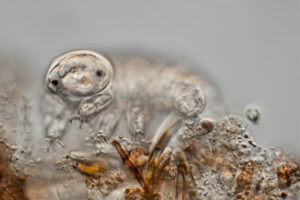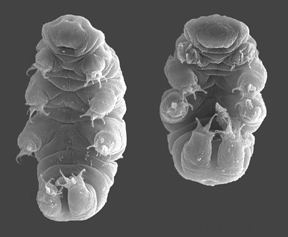
Tardigrades, also known as waterbears or moss piglets, are microscopic invertebrates that “resemble a cross between a caterpillar and a naked mole rat,” according to science writer, Jason Bittel. First discovered almost 250 years ago, there are now over 1,000 known species of tardigrade that can be found in almost every habitat throughout the world – from the depths of the ocean, to the tops of mountains, to your own backyard. As long as there is a little bit of moisture, you can find them. They are small and chubby, with most species being less than one millimeter in length. Their unique, usually transparent bodies have no specialized organs and four pairs of legs with claws at the end. Tardigrades can reproduce sexually or asexually via self fertilization. Like regular bears, Tardigrades eat a variety of foods, such as plant cells, animal cells and bacteria.
Despite being small, adorable microorganisms, tardigrades are fascinating creatures that have recently garnered the attention of scientists around their world due to their adaptability and resilience towards the most extreme environmental conditions. They have been observed to survive in a vacuum (an environment devoid air and matter) for up to eight days, for years to decades without water, temperatures ranging from under -200˚C to almost 100˚C, and heavy ionizing radiation. Tardigrades survive these conditions through a reversible mechanism known as desiccation (extreme drying), in which an organism loses most of the water in their body. In tardigrades, this can be as high as 97%. This is especially important in freezing temperatures, where water frozen into ice crystals can pierce and rupture the cells in the tardigrades’ body. During desiccation, the metabolic rate slows down to as low as 0.01% of normal function, allowing survival under the harshest of conditions for years.

In a 2016 Nature paper, scientists sought to answer the question of how a certain specie of tardigrade, Ramazzottius varieornatus, is so tolerant to extreme environmental conditions. They found an increase in several stress-related gene families such as superoxide dismutases (SODs). Most multicellular animals have less than ten SODs, however the study identified sixteen in this tardigrade specie. They also found an increased copy number of a gene known to play an important role in DNA double stranded breaks, MRE11. R. varieornatus had four copies of MRE11 while most other animals have only one. Aside from having improved mechanisms of handling stress and DNA damage, scientists were able to identify waterbear-specific genes that seemed to explain tardigrades’ radiotolerance, or rather, resistance to radiation. The scientists were curious about whether this tardigrade-specific gene had any effect on DNA protection and radiotolerance in human cells. To their surprise, this gene, called DSUP for DNA damage suppressor, was able to decrease DNA damage in human cultured cells by 40% and decreased both double and single stranded DNA breaks.
At the University of North Carolina at Chapel Hill, Dr. Bob Goldstein studies animal development and cellular mapping during development in C. elegans and recently in tardigrades as well. He is also focusing on developing tardigrades into an new model system while studying their body development! His lab website has a section dedicated to tardigrades, with resources about them along with pictures and videos of tardigrades in motion.
The environmental resilience of tardigrades is incredible, making the tardigrade the super-animal of the animal kingdom (in my opinion). Who knows what other fascinating creatures we have yet to discover that may have characteristics as interesting and unbelievable as those of the tardigrade?
Peer edited by Nick Martinez.
Follow us on social media and never miss an article:
Very interesting and possible benefits to humans. Although I would not characterize them as “adorable “